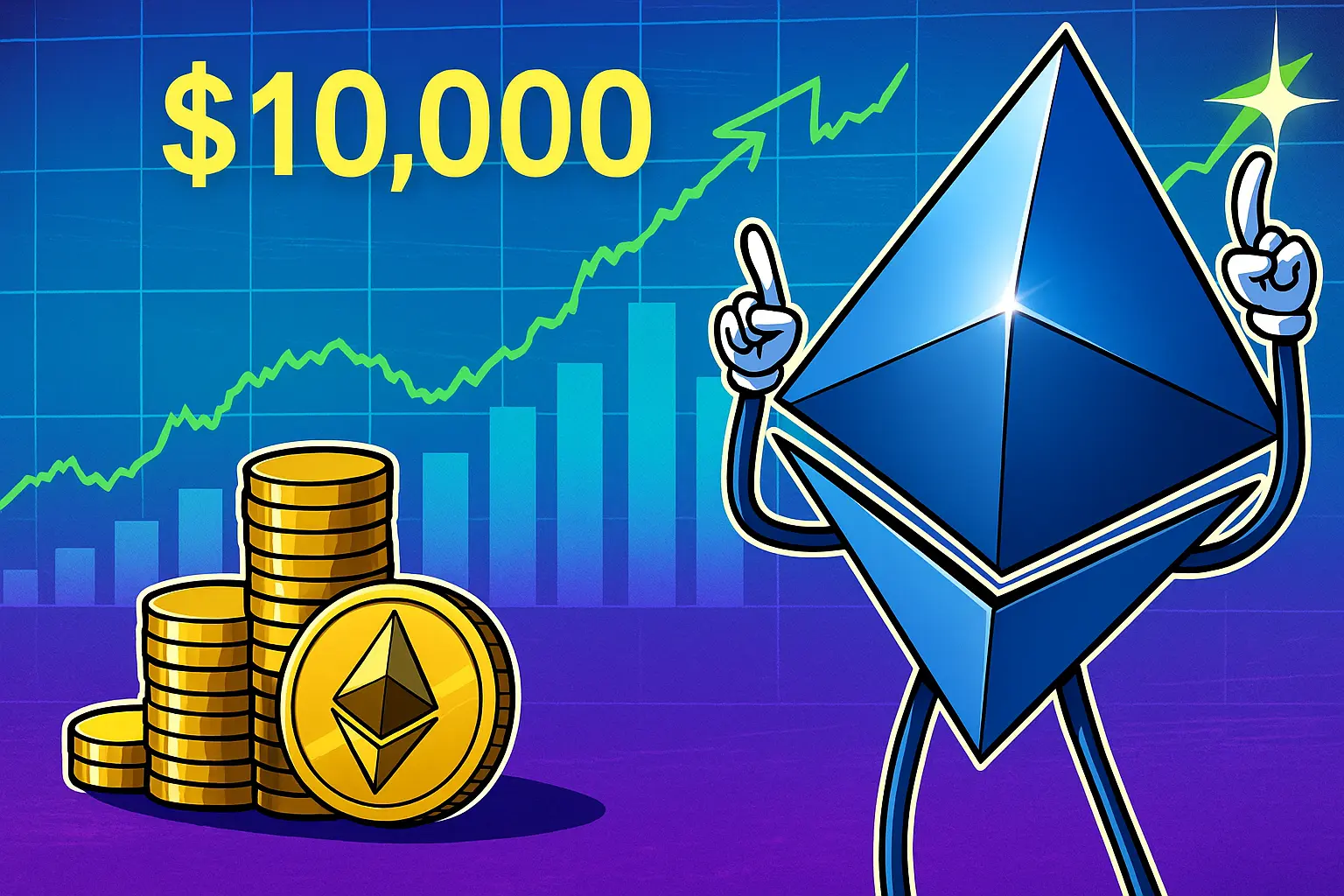Over the past weeks, Ethereum (ETH) has staged a rally that has taken even seasoned market observers by surprise. Trading above $4,300 with a market capitalization exceeding $520 billion, the world’s second-largest cryptocurrency has now surpassed Mastercard and Netflix, ranking as the 22nd most valuable asset globally. ETH sits just 13% below its November 2021 all-time high. This momentum comes as the total cryptocurrency market capitalization has crossed $4 trillion for the first time ever. While Bitcoin consolidates near its own record levels, Ethereum has moved into the spotlight.
Billion-Dollar Buying Drives the Surge
One of the strongest drivers is institutional demand. In the past seven days alone, an as-yet unidentified institution accumulated 221,166 ETH worth nearly $1 billion. The purchases, routed through brokers such as Galaxy Digital, FalconX, and BitGo, were split across six wallets.
Between August 3 and August 11, Bitmine Immersion Tech expanded its Ethereum holdings by 525,263 ETH — worth around $2.28 billion. On-chain data from strategicethreserve.xyz highlights this as one of the largest institutional accumulations in months, alongside SharpLink Gaming’s $400 million Ether purchase.
Publicly traded companies now hold an estimated 966,000 ETH (~$3.5 billion) on their balance sheets, up sharply since the start of the year. Strategic ETH Reserve data shows 65 specialized Ethereum treasury firms collectively controlling around 2.73 million ETH — about 2.3% of total supply — valued near $10.5 billion. ETF activity is also booming: August 9 alone saw $461 million flow into Ethereum ETFs, the third-highest daily figure on record. In their first year, inflows have totaled $8.7 billion.
Technical Analysis Points to More Upside
Analysts believe this may be the beginning of a larger bullish phase. “Crypto Rover” notes a breakout from a multi-year symmetrical triangle pattern, projecting a target near $8,000. “Titan of Crypto” sees fractal similarities to Bitcoin’s summer 2020 setup — which preceded a new ATH — suggesting ETH could potentially hit $12,000.
#Ethereum The run-up phase is here 🚀
— Titan of Crypto (@Washigorira) August 11, 2025
Breakout ✅ Retest ✅ Next stop: price discovery 📈 pic.twitter.com/4UfnR34E3H
The broader market context supports these scenarios — for now. The altcoin market’s rebound has coincided with a decline in Bitcoin dominance, now sitting on a key long-term support. Several high-timeframe divergences (1D to 3D) hint at a possible bottoming process, which could shift market momentum back toward BTC in coming weeks.
The crypto market’s Total 2 index (excluding Bitcoin) is testing a major resistance level. A decisive breakout could open the door to price discovery, giving Ethereum room to run. Failure would keep the $1.25 trillion zone as a key support.
For ETH, a sustained weekly close above $4,000 could quickly pave the way toward $4,800. Without that, or if BTC turns corrective, a pullback toward $3,800–$3,600 remains on the table.
On-Chain Data: Long-Term Bullish, Short-Term Mixed
CryptoQuant data shows a structurally bullish trend: Ethereum’s Exchange Supply Ratio (ESR) across all exchanges has been falling since 2022, now at 0.16 — one of the lowest in three years. This indicates less ETH held on exchanges, tightening long-term supply.
Short-term caution comes from Binance data, where ESR has risen from ~0.036 to 0.04 this year, alongside positive net inflows — suggesting some traders may take profits near $4,400. A clean breakout above that level could set the stage for $4,800 and another all-time high test, but sustained selling pressure might push ETH back to $3,950–$4,000.
Ethereum Staking: Growth, Centralization, and the Role of Liquid Staking
Staking participation continues to climb. Beaconcha.in reports around 29.13% of ETH’s total supply — over 36 million ETH — is now staked. Active validators have topped 1.12 million, with average annual staking yields at roughly 3%, still appealing to long-term holders despite lower rewards than in the early post-Merge period.
The staking market is heavily concentrated. Lido controls ~8.87 million ETH (24.5% of all staked ETH), followed by Binance (3.03M / 8.4%), Coinbase (2.43M / 6.7%), ether.fi (2.27M / 6.3%), and Kraken (1.29M / 3.6%). Combined, these five entities account for over 49% of all staked ETH — sparking ongoing community debates over centralization risks.
In the liquid staking sector, Lido dominates with 86.8% market share — more than all other providers combined. Critics warn that such concentration could pose governance and security risks, while supporters highlight the convenience and liquidity benefits.
Meanwhile, centralized exchanges like Binance and Kraken have seen a gradual decline in their ESR since mid-2024, partly due to tightening regulations in the U.S. and Europe. Decentralized protocols are slowly but steadily gaining market share.
Institutional staking is also growing. Dune Analytics data shows a rising share of deposits coming from wallets linked to custody providers and institutional validator services — a shift that could professionalize the sector further, but also concentrate influence.
ETF Inflows and Staking Impact
Spot Ethereum ETFs could reshape staking dynamics. Institutional ETF inflows could increase market liquidity in the short term, while some issuers might stake portions of their holdings, further reducing circulating supply.
Market Sentiment: Euphoria with FOMO Risk
Google Trends data shows global search interest for “Ethereum” has surged to a yearly high. Such spikes often coincide with increased trading activity — and can precede either parabolic moves or sharp corrections. Social media sentiment is overwhelmingly bullish, amplifying the fear of missing out (FOMO) effect.
Fundamentals: Ethereum Upgrades and Buterin’s L2 Strategy
Ethereum’s Pectra hard fork in May 2025 brought key upgrades: increased validator limits, more stable gas fees, and a new security framework from the Ethereum Foundation.
Vitalik Buterin has emphasized faster withdrawal times on Layer-2 solutions, aiming for sub-one-hour withdrawals (and potentially ~12 seconds in the future) over formal “Stage 2” rollup decentralization. His goal: position Ethereum L1 as the primary platform for asset issuance and the economic hub of the ecosystem. He sees zero-knowledge proofs as a core enabling technology.
Amazing to see so many major L2s now at stage 1.
— vitalik.eth (@VitalikButerin) August 6, 2025
The next goal we should shoot for is, in my view, fast (<1h) withdrawal times, enabled by validity (aka ZK) proof systems.
I consider this even more important than stage 2.
Fast withdrawal times are important because waiting a… https://t.co/YZs2hQ3Wrn
Macro View: Potential in the 2025 Cycle
OKX partner and investor Ted Pillows calls Ethereum “the fastest horse in the race,” expecting the rally to continue. While Bitcoin, gold, and the S&P 500 have already hit new highs this year, ETH remains ~15% below its 2021 peak — a gap Pillows believes could close in 2025, with $10,000 as a realistic cycle target driven by institutional demand.
Risks: Leverage and Regulation
Despite the bullish outlook, Buterin warns against excessive leverage in corporate treasuries. Macroeconomic shifts, interest rate policy, and regulatory changes could slow momentum. Overheated sentiment could also spark sharp short-term corrections.

